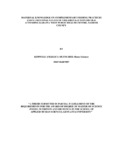| dc.description.abstract | Worldwide, malnutrition is responsible directly or indirectly for deaths of children under
five years. Two thirds of these deaths are associated with inappropriate feeding practices.
Interventions that address child malnutrition show that appropriate complementary
feeding practices can save up to 6% deaths in under-fives. Attention should therefore be
given to decisions taken by the mother during complementary feeding. Thus the purpose
of this study was to determine mothers‟ knowledge on complementary feeding practices
and relate this to the nutritional status of their children aged 6-23 months. The study
adopted a cross-sectional analytical study design and was carried out at the Kahawa West
Public Health Centre among the randomly sampled 286 mothers and their children. A
researcher-administered questionnaire and a focus group discussion were used to collect
data. Data was entered and analyzed using (SPSS version 20). Anthropometric
measurements were analyzed using ENA for SMART. Chi-square test (p< 0.05) was used
to show the relationships between the child‟s nutritional status and the mothers‟
knowledge on complementary feeding practices. Logistic regression was used to establish
the predictors of children nutritional status in the study population. The respondents were
mostly young (mean age 26.1±4.7 years), married (88.1%), housewives (66.4%) with
mainly primary school level of education (47.2%). The main sources of income for most
households were business (48.6%) and casual labour (31.8%). Mothers had average
knowledge on complementary feeding (14.11±2.33) out of the 20 knowledge questions.
All (100%) the children aged 6-8 had been introduced to solids, semi-solids and soft
foods. Majority of the breast-fed children received minimum meal frequency; 6-8 months
old (95.9%) and 9-23 months old (96.4%) unlike the non-breast fed children (55.0%).
The percentage of children who consumed vitamin A rich foods was 60.8% and iron-rich
foods were 11.5%. Over three quarters (79.0%) of the children attained the minimum
dietary diversity whereas 75.9% attained the minimum acceptable diet. Overall, 13.3% of
all the children were stunted, 11.9% wasted and 16.8% underweight. Maternal knowledge
on complementary feeding was significantly associated with nutritional status of their
children. Mothers‟ knowledge on feeding the sick and recovering children was related to
underweight in children (chi-square test; p=0.026). The same was true of mothers who
knew that a child‟s main meal should be diversified (chi-square test; p=0.027). There was
a significant relationship between mothers‟ knowledge on duration of exclusive
breastfeeding (chi-square test; p=0.022) and feeding bottles (chi-square test; p=0.005)
and wasting in their children. Children who did not attain the minimum meal frequency
were likely to be wasted (chi-square test; 0.001 and underweight (chi-square test; 0.013).
Mothers‟ knowledge on complementary feeding practices was not significantly related to
her complementary feeding practices (p>0.05). Nutrition messages on Infant and Young
Child Feeding Practices should emphasis dietary diversity and frequency of feeding
especially for non breastfed children and also on how to feed sick children. Nutrition
programmes should pay attention to cultural beliefs on infant and young child feeding. A
longitudinal study on factors that may influence complementary practices is also
recommended. | en_US |

